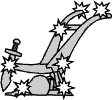Our Own Devices: national symbols and political conflict
Ian McKeane reviews Our Own Devices: national symbols and political conflict in twentieth-century Ireland by Ewan Morris, Irish Academic Press, ISBN 0 7165 3335 5, €27.50/£20 pbk

ICONOGRAPHY CAN seem an esoteric subject which somehow lies on the periphery of more serious study of historical events. Yet, when we remember Hobsbawm's masterly study of the role of national icons in the construction of notions of national identity we realise that Ewan Morris's book is an essential tool for understanding the iconography of the Irish Free State and Northern Ireland.
The book has two broad sections which deal with the evolution of the national or provincial symbols which have grown out of the two traditions in Ireland. The whole notion of the use and interpretation of national symbols and the generality of Irish national symbols before 1922 are discussed in the first two chapters.
This introduction is followed by a detailed historical review of the national symbols of the Free State. The account of the political implications of the almost accidental adoption of the tricolour by the Cumann na nGaedheal government as a national flag and the Soldier's Song<.em> as a national anthem make for fascinating reading.
The furore which erupted around the designs for the new Free State coinage and its stamps is also page-turning stuff. How one of Europe's most beautiful coinage sets provoked such outrage is truly astonishing. The author quotes a columnist of the Drogheda Argus in 1928 who, after noting that the same designer had worked on new coinage for Iraq, wondered if "designs appropriate for the heathens in Irak (sic)" were fit for coinage in a "Christian and civilised and cultured country like Ireland".
The different issue which arose in Northern Ireland after partition is intelligently discussed. The unionists saw the British flag as the flag of Northern Ireland. However, the use of the Irish tricolour by a significant minority as a 'party' flag and the slow metamorphosis of the Empire into a Commonwealth of independent states weakened the adequacy of this view. Morris shows how, following the example of the Irish Free State, other dominions introduced their own flags and anthems.
Morris concludes by summarising his thesis that the Irish of whatever dispensation were not unlike in their diffidence in adopting national symbols. He reminds us that Hobsbawm suggests that national iconography developed mainly since 1870 and, in particular, in states which had a recent history of national or political self-definition. He suggests that in Ireland this was less urgent since Irishness in Ireland was not in question and the political system in the twenty-six counties evolved over a number of decades. It was this evolution which was to drive the unionists in the six counties to seek their own provincial symbols.
More and better quality illustrations would have improved this book but it is a fascinating, detailed and readable analysis by a New Zealander whose detachment adds to its quality.
Connolly Association, c/o RMT, Unity House, 39 Chalton Street, London, NW1 1JD
Copyright © 2005 Ian McKeane

